Most Expensive Commutes in America (2025)
The cities with the most expensive commutes are primarily on the East and West Coasts. The top two most expensive are Fremont, CA, and San Francisco, CA. Lubbock, TX, is the top city with the least expensive commute.
Free Car Insurance Comparison
Compare Quotes From Top Companies and Save
Secured with SHA-256 Encryption
Justin Wright
Licensed Insurance Agent
Justin Wright has been a licensed insurance broker for over 9 years. After graduating from Southeastern Seminary with a Masters in Philosophy, Justin started his career as a professor, teaching Philosophy and Ethics. Later, Justin obtained both his Property & Casualty license and his Life and Health license and began working for State Farm and Allstate. In 2020, Justin began working as an i...
UPDATED: Jul 12, 2024
It’s all about you. We want to help you make the right coverage choices.
Advertiser Disclosure: We strive to help you make confident auto insurance decisions. Comparison shopping should be easy. We are not affiliated with any one auto insurance provider and cannot guarantee quotes from any single provider. Our partnerships don’t influence our content. Our opinions are our own. To compare quotes from many different companies please enter your ZIP code on this page to use the free quote tool. The more quotes you compare, the more chances to save.
Editorial Guidelines: We are a free online resource for anyone interested in learning more about auto insurance. Our goal is to be an objective, third-party resource for everything auto insurance related. We update our site regularly, and all content is reviewed by auto insurance experts.
UPDATED: Jul 12, 2024
It’s all about you. We want to help you make the right coverage choices.
Advertiser Disclosure: We strive to help you make confident auto insurance decisions. Comparison shopping should be easy. We are not affiliated with any one auto insurance provider and cannot guarantee quotes from any single provider. Our partnerships don’t influence our content. Our opinions are our own. To compare quotes from many different companies please enter your ZIP code on this page to use the free quote tool. The more quotes you compare, the more chances to save.
On This Page
The average American spends a lot of time, money, and energy on commuting, affecting personal time. Although commute costs vary from state to state and city to city, it’s concerning that many Americans lose money on their commute due to their location. You also have to factor in the cost of your car and auto insurance.
Keep reading to find out if your state or city falls within the most expensive category on our list.
Our guide will look at how expensive commutes affect your time and savings, fueling the Great Resignation and the future of work.
- Five out of the 10 cities with the most expensive commutes are located in California
- Four out of the 10 cities with the least expensive commutes are located in Texas
- East and West Coast cities have the most expensive commutes in the United States
Cities With the Most Expensive Commutes
In major cities all over the United States, residents pay high costs to get to work. Public transit is expensive, and traffic can be a nightmare. When you add this all up, commute expenses are not a small price to pay.
Are you planning to relocate or want to figure out if your new job is worth the cost of a high-end commute? Here are the ten cities with the most expensive commutes across the country.
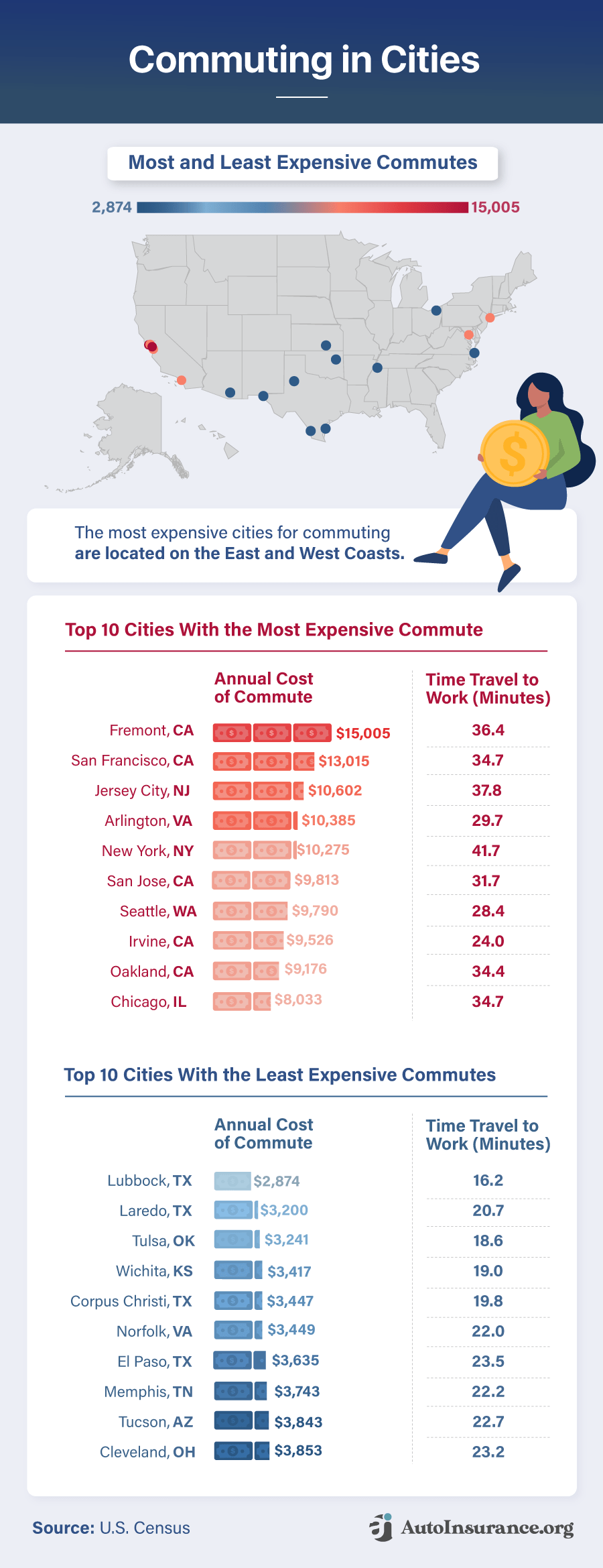
Commute costs are high across California, with half of the cities among America’s ten worst commute cities.
Fremont, the most expensive city, is more than $6,000 above the ninth-placed Oakland. Yet, both cities are in the state.
On the East coast, workers in Chicago spend the same hours in traffic commuting to work as those in San Francisco. However, the San Francisco drivers pay $4,982 more than those in Chicago.
Take a more informed look below at how these top 10 cities with expensive commutes rank against each other in terms of worked hours, wages, and travel time to work.
#10 – Chicago, Illinois
Annual average commute cost: $8,033
Average travel time to work: 35
Weekly average hours worked: 39
Median workers’ yearly salary: $54,316
The Windy City is the tenth city with the most protracted and expensive commute. If you’re planning to commute or travel around Chicago, Illinois, you’ll want to estimate your expenses reasonably in advance.
Your annual commuting cost could be around $8,033, averaging $32 daily. Plus, if you drive to work, you’ll be spending an average travel time of 35 minutes just to get there. This is all in addition to your auto insurance coverage.
When the typical Chicago worker earns about $54,316, which is $28 hourly, at an average of 39 hours per week, commuting can take a toll on your mood and energy, impacting your opportunity costs.
#9 – Oakland, California
Annual average commute cost: $9,176
Average travel time to work: 34
Weekly average hours worked: 39
Median workers’ yearly salary: $62,101
Oakland, California, is the ninth most expensive city for commuters, with workers spending $37 a day on average and $9,176 annually. The average travel time to work is 34 minutes, meaning workers spend more time commuting than in other cities.
The median annual income of $62,101 is respectable, with $32 as an hourly wage. Commuters in Oakland share an average with other cities on our list regarding working hours (39 hours).
#8 – Irvine, California
Annual average commute cost: $9,526
Average travel time to work: 24
Weekly average hours worked: 38
Median workers’ yearly salary: $90,979
Irvine, California, is the eighth-most expensive city for commuters. Workers spend an annual $9,526, or a daily $38 getting to and from work. Most employees in Irvine work 38 hours a week for a reasonable pay rate of $48 per hour.
Regardless, the city has some of the highest wages in the country. An average worker earns $90,979 as a median salary and has an average commuting length of 24 minutes.
#7 – Seattle, Washington
Annual average commute cost: $9,790
Mean travel time to work: 28
Weekly average hours worked: 39
Median workers’ yearly salary: $81,290
Seattle, Washington’s cost of living keeps going up. Rent isn’t the only expense hurting your wallet. The average commute in Seattle costs $9,790 on average per year. Incomes are growing, too, but not nearly enough to keep up with expenses.
The average commute time is 28 minutes. The mean travel time to work is lower, at 28 compared to other cities. The median earnings of workers is a remarkable $81,290 per year, which is one of the highest incomes for all cities and towns on this list.
#6 – San Jose, California
Annual average commute cost: $9,813
Mean travel time to work: 32
Weekly average hours worked: 39
Median workers’ yearly salary: $71,323
San Jose, California, is the sixth city with the most expensive commute. The annual commuting cost is $9,813, and the daily average is $39.
Expensive? Yes, the cost of commuting is high. Let’s look at how that compares to wages.
San Jose workers earn a median of $71,323 per year, making that an hourly wage of $37. While the income is attractive, working 39 hours on average per week, and spending 32 minutes as the mean travel time to work, can make anyone look elsewhere for cities with better alternatives.
#5 – New York, New York
Annual average commute cost: $10,275
Mean travel time to work: 42
Weekly average hours worked: 39
Median workers’ yearly salary: $57,224
New York is the fifth most expensive city for commuters. The $10,275 annual commute cost statistic doesn’t even include the cost of your car and other expenses.
A typical commuter in New York works 39 hours working every week, with a mean travel time of 42 minutes. How much do the average New Yorkers get paid? It breaks down to about $30 hourly, with the annual median earnings at $57,224.
Compared to cities with more expensive commutes like Fremont and San Francisco, New Yorkers have less disposable income. The wages don’t compensate for the high opportunity costs, such as the time spent with friends and family instead of sitting in traffic.
#4 – Arlington, Virginia
Annual average commute cost: $10,385
Mean travel time to work: 30
Weekly average hours worked: 41
Median workers’ yearly salary: $86,640
Arlington, Virginia, is the fourth most expensive city for commuters due to its high-tech and defense industries. The Federal Government makes up a large part of the local economy and is one of its largest employers.
At $42 a day and $10,385 every year, the city’s commute cost is not very affordable. You can expect to spend about 30 minutes commuting to work, leading to 41 average hours worked.
The average worker earns a substantial $86,640 a year, and the average hourly wage breaks down to about $42. Although the wages are high, workers prefer to commute from neighboring cities with affordable costs, such as Falls Church. Still, they’d need to bear with longer commuting hours.
#3 – Jersey City, New Jersey
Annual average commute cost: $10,602
Mean travel time to work: 38
Weekly average hours worked: 40
Median workers’ yearly salary: $67,146
Jersey City, New Jersey, is the third most expensive city for commuters in the U.S. It has over 250,000 people, making it one of the more densely populated areas in the country.
A typical employee in Jersey City spends $42 every day, totaling $10,602 per year. The average commute to work in this area takes close to 38 minutes with an hourly wage of $34. Workers average 40 hours per week, earning $67,146 as the median earning.
#2 – San Francisco, California
Annual annual commute cost: $13,015
Mean travel time to work: 35
Weekly average hours worked: 40
Median workers’ yearly salary: $90,475
San Francisco, California, is the second most expensive city, with a commute that costs $52 daily, averaging $13,015 per year. The city’s high cost of living has been attributed to years of insufficient housing production coupled with a booming economy.
According to our researchers, the city’s mean travel time to work is 35 minutes. The average hours worked per week is 40, with the median workers’ earnings pegged at a considerable $90,475.
#1 – Fremont, California
Annual average commute cost: $15,005
Mean travel time to work: 36
Weekly average hours worked: 39
Median workers’ yearly salary: $95,221
Fremont is the most expensive city for commuters on our list. If you’re living there, the amount of money you spend on commuting can negatively affect your quality of life.
The average commute time in Fremont is 36 minutes, which means residents spend long hours in traffic than in other cities. Aside from time, they also bear more costs. The daily commute cost is $60, totaling $15,005 every year.
Are these hours and costs commensurate with wages? Fremont compensates residents with an hourly wage of $50 at 39 average hours worked, which is about 65% higher than Chicago’s.
Besides, the median workers’ earnings of $95,221 are nearly double most cities’ earnings on this list, suggesting a higher disposable income.
Free Auto Insurance Comparison
Enter your ZIP code below to view companies that have cheap auto insurance rates.
Secured with SHA-256 Encryption
Cities With the Least Expensive Commute Costs
After reading about cities with the most expensive commute costs, it’s only fitting to dig into those with the least expensive commute costs.
These cities are relatively close to what you would expect regarding the cost of living and wage rates, yet have such low commute costs. This can be attributed to a variety of factors. However, many of these cities tend to be suburbs of other major metropolitan areas.
Full-time workers in cities with the least expensive commutes save $3,200 annually, while cities with the most costly commutes pay $5,900 more each year.
If your dream job lies across the country, you might want to move to Lubbock, Texas. With an average commute cost of $2,874 per year and a mean travel time of 16 minutes, this city has some serious bragging rights for the cheapest commute. But it’s not the only one.
Residents in Laredo, Texas, have the least expensive commute costs in the country. Apart from low housing and low fuel, Laredo workers have a reasonable commute time of 21 minutes, with a low annual cost of $3,200.
With a mean travel time of 19 minutes, Tulsa, Oklahoma, has the shortest average commute time. This is the first non-Texas city in the ranking with a reasonable annual commute cost, pegged at $3,241.
While these cities are smaller than some of the cities on the most expensive list, they may be a great alternative and allow you to immensely save money on your commuting costs each day.
States With the Most and Least Expensive Commutes
In most American states, commutes raise the cost of living. Some states are worse than others when it comes to commuting costs, and yours might be one of them.
The following graphic ranks your state and those around you. Our researchers considered the relevant factors that directly impact how much money Americans spend commuting: mean travel time to work, median workers’ earnings, and average hours worked.
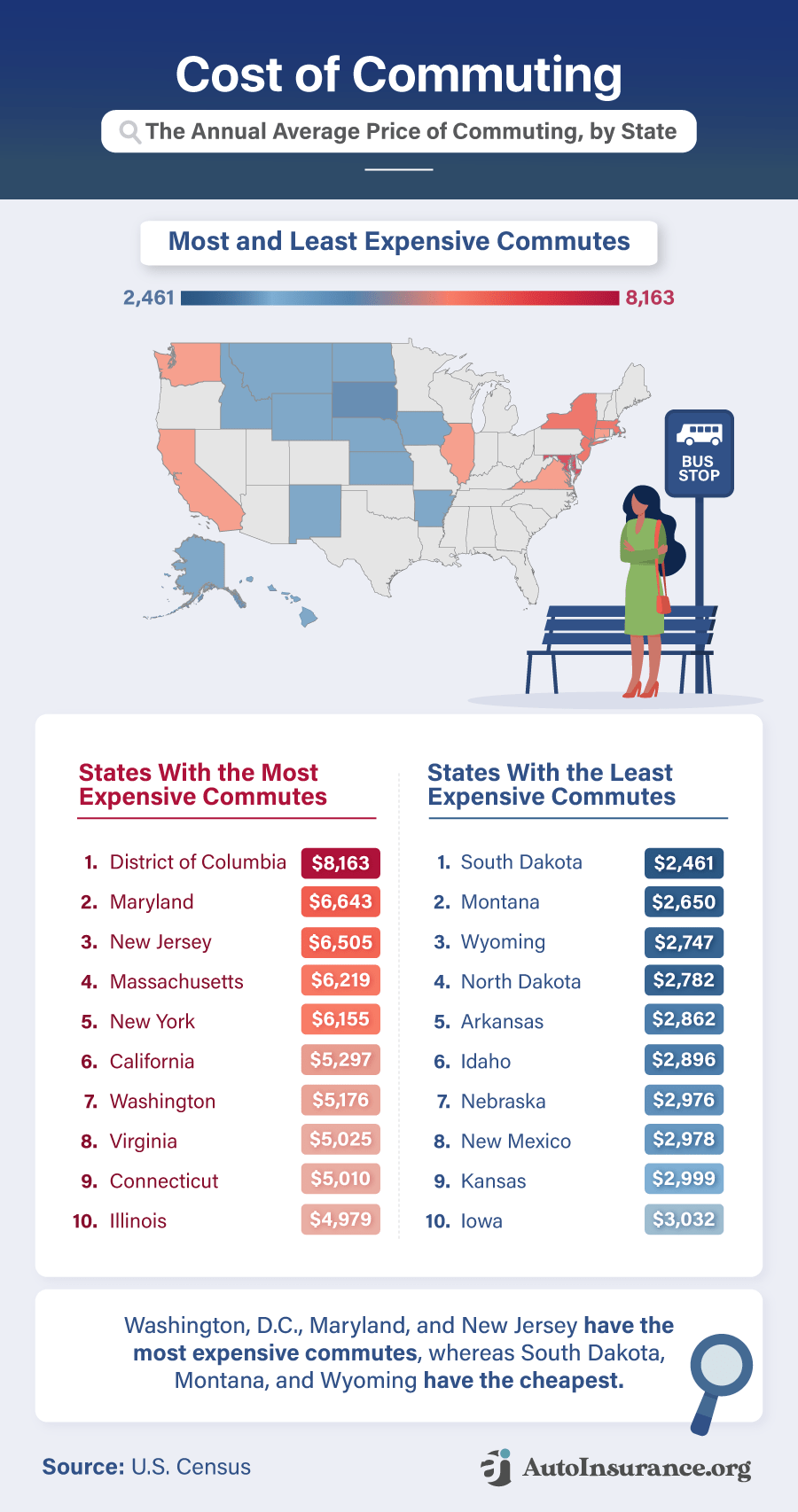
Although the five least expensive states share the same average working hours as the most expensive, workers spend only 19 minutes on average commuting to work compared to 33 minutes in expensive states.
When comparing the most expensive state with the least expensive state, the difference is huge. The District of Columbia enjoys a high standard of living and has higher median workers’ earnings ($61,960) and mean travel time to work (32 minutes). It is also the state with the most expensive commute, with a higher commute cost than any other state.
In contrast, the state with the cheapest commuting cost is South Dakota, which has a shorter mean travel time to work (18 minutes) and a lower median workers’ earnings ($32,908). Still, it boasts the lowest commute costs among the states, although its average hours worked are the same.
Maryland has the second most expensive annual commute costs ($6,643). The average Maryland worker commutes 34 minutes to work, spending long hours in traffic. When we look at the second cheapest state for commuting, Montana, travel time (20 minutes) and cost ($2,650) are both much lower.
If you live in Massachusetts, you spend an average of $6,219 on your annual commute. But in North Dakota, the costs and traffic time are much lower, just $2,792 per year on a modest mean travel time of 18 minutes to work.
Impact of COVID-19 on Commuting and Work Days
In 2020, the outbreak of COVID-19 forced the world into a lockdown, impacting all aspects of life, including work. Two years later, the world is still trying to find ways to curb the spread of the virus. Social distancing, vaccination, and other measures remain in the aftermath of the Coronavirus.
The Effects of COVID-19 on Commuting
Enclosed spaces, crowded areas, and close contact with people are three significant factors that propel the spread of COVID-19. When you think of these factors, public transport has all of them. Commuting, whether to or from work, increases the odds of contracting an infected person.
Working from home has helped reduce the stress of commuting and the number of daily commuters on the road. It has also reduced the number of people at work and ultimately helped curb the spread of the virus.
The Great Resignation and COVID-19
The U.S. Bureau of Labor Statistics (BLS) reported that in 2021, more than 47 million Americans resigned from their jobs. This figure was unanticipated and unprecedented, and many people believe it can be linked to the COVID-19 lockdown. Being at home allowed Americans to reevaluate their lives and figure out what they needed.
People had time to apply for better jobs, gathered the courage to leave toxic jobs, felt comfortable working from home, and decided not to return to any office space. These are only a few of the many reasons that triggered the mass resignation, dubbed the Great Resignation. While most of these companies are suffering the effects of the Great Resignation, many workers are starting new businesses for themselves.
Work-Life Balance Discovered During COVID-19
Before COVID-19, employees spent a large part of their day focusing on working. Creating a balance between work, personal affairs, family matters, and other involvements was difficult. As a result of COVID-19, working remotely has helped people have more control of their lives and everything around them.
Parents could spend more time with their children, couples spent more time with their partners, and it was possible to do all of these while still giving your best at work. Having a work-life balance makes you happier, and being happy allows you to give your best at work.
According to a Harvard Business Review (HBR) study, working from home has helped managers and independent employees gain 23 and more than 60 minutes of personal time, respectively. On average, people have 37 minutes more personal time to themselves every day by staying at home and performing office duties.
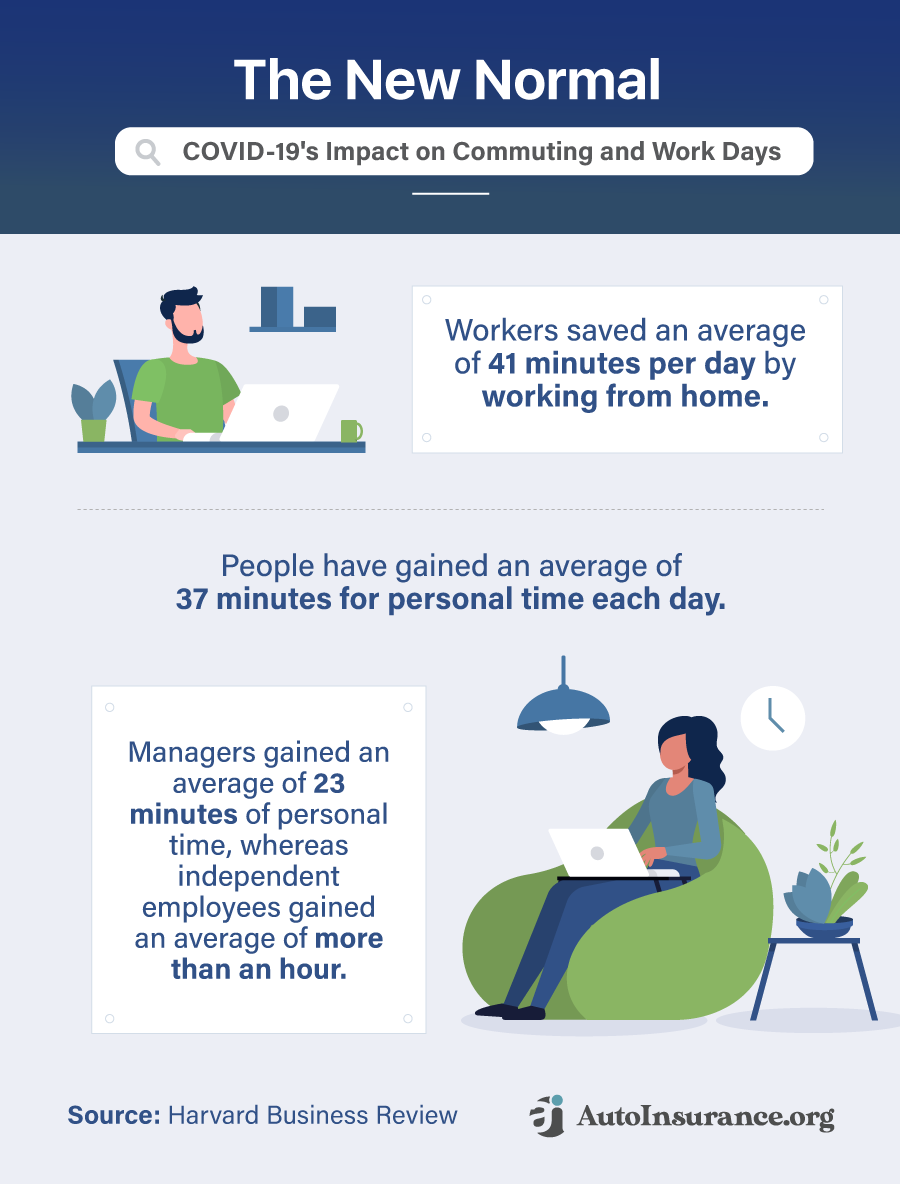
Free Auto Insurance Comparison
Enter your ZIP code below to view companies that have cheap auto insurance rates.
Secured with SHA-256 Encryption
Money Saved Working from Home (By Industry)
One of the benefits of working from home is that it saves money on your commute and other expenses. Expenses tend to be much more when people have to leave their homes. This has been proven by the data collected across industries on the estimated amount of money saved by people by working from home. Take a look below.
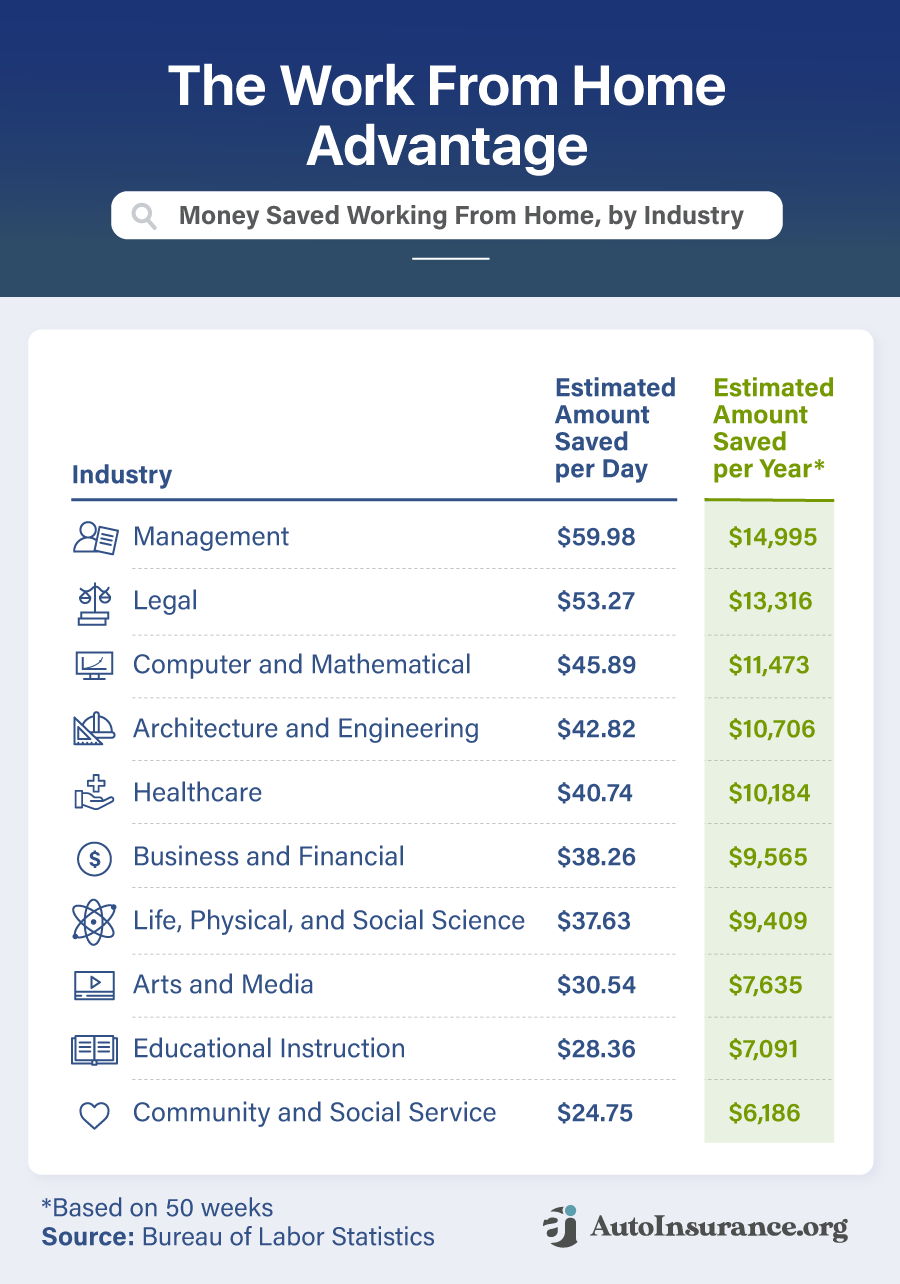
The management industry recorded the highest amount of money saved. Workers in firms and corporations became even more productive. In the management industry, the money saved by not commuting to work is equivalent to an estimated $59.98 per day and $14,995 per year.
Looking at the legal industry, not all workers may be able to comfortably do their job remotely. However, for those who can, an estimated $53.27 was saved per day or $13,316 per year.
The data collected found that people could also save money from the healthcare industry by working from home. Again, there are a lot of healthcare professionals who can’t do their jobs from home, but those working in an office setting who can comfortably work from home can save a lot of time and money. In the medical industry, people saved an estimated $40.74 per day and $10,184 per year.
Other industries in the top 10 are Arts and Media ($30.54 per day, $7,635 per year), Computer and Mathematical ($45.89 per day, $11,473 per year), Architecture and Engineering ($42.82 per day, $10,706 per year), Business and Financial ($38.26 per day, $9,565 per year), Life, Physical, and Social Science ($37.63 per day, $9,409 per year), Educational Instruction ($28.36 per day, $7,091 per year), Community and Social Service ($24.75 per day, $6,186 per year).
The data outcomes prove that working from home is economically efficient for people during the switch to remote working if they are able.
What The Government Can Do To Reduce Commute Costs
The ease of living is crucial to the well-being of any country. The government is saddled with the responsibility of making sure its people live with ease to achieve their purposes optimally. When you consider the ease of commuting, it is an essential factor that should be addressed.
The government can create economic policies that are designed to enhance public transportation in a bid to reduce commute costs. This is the way to go. When there is a rise in the gig economy that thrives on remote working, the government must be considerate.
Sherrie Ashley, the Co-Founder at PeopleFastFind.com, a people and information search engine, says, “Improving transport infrastructure can mitigate the increasing cost of commuting. The government can formulate policies to improve public transportation.
“The high price of commuting to a physical office is one of the many reasons that informed the Great Resignation. Virtually all companies are now considering remote work to help their employees save on transportation.”
How To Save Money on Commuting
While commute costs can threaten your financial stability, there are tips you should follow to reduce your commute costs. If you commute to your office daily or as a hybrid worker, you can reduce your commuting costs by being cognizant of your budget and choosing other options like carpooling, sharing a car, riding a bike, using public transportation, or walking.
When your distance to work is walkable, walking could be a better choice than commuting. It saves money and is good for your health. Sherry Morgan, the founder of Petsolino.com, advises workers to adopt bicycles.
Morgan says, “Many municipalities promote bicycling by offering sponsored bike share programs and commuting bike lanes. Walking or riding a bike provides considerable health benefits and saves money.
“Carpooling is especially useful when people regularly go to and from the exact location. Even if you need to use a car, it doesn’t have to be yours. Applying these simple strategies will allow you to save money on your commute costs.”
Understanding the Economics Behind the Rise and Fall of Commute Costs
Seeking more information about the economic factors behind commuting costs and their impact on personal health and the future of work? We’ve collected advice, insights, and tips from professionals across several fields and disciplines. So, read on to see what the experts have to say about commutes and their effects on American society.

“The price of fuel is a hot topic at the moment, but a myriad of factors dictates the cost of your commute. One factor is the impact of profession and industry on commuting. It’s easy for tech companies to locate in plush downtown offices near public transit, but extensive manufacturing facilities need space.
To access this space, they often choose sites out of town, which means a little further away from transportation and housing. Will people start switching out of professions located further from transport hubs out of necessity? If commuting costs continue to rise, it has to be a worry for employers.”
What do you think the government can do to mitigate increasing costs?
“Fuel subsidies are the answer here. The economics of fossil fuels aren’t going to improve in the medium to long term, so it’s time to look elsewhere. Could more be done to help make electric vehicles more accessible for people?”
Which three sectors in the economy are directly affected by high commuting costs?
“High commuting costs are bad news for a lot of people. With hybrid work growing in popularity, attracting workers back to the office will only be more challenging for employers if it is too expensive.
EV car manufacturers and other responsible commuting companies can benefit by showing consumers how they can save a lot by spending a little upfront.”
To what extent does high-cost commuting inform the Great Resignation and drive the future of the workplace?
“How big of the issue the cost will be is hard to predict at the moment. The time investment is the point employees struggle to reconcile with. Workplaces will begin to evolve and become much more destination-style environments.
Think of them as shopping centers for work. There will be lovely bright open spaces with plenty of room for collaboration, and access will be easy, whether by public transport or plentiful parking.
Employees will not be expected to be there all the time but will come in periodically to connect with colleagues and collaborate on significant projects.”
What’s the correlation between commute costs and remote working, especially in the gig economy?
“Cities with high levels of young skilled professionals, which are also tourism hubs, will start to feel the crunch here.
Many younger workers crave the sense of community and connection from office-based work, but they are no longer prepared to sit in traffic for an hour twice a day to experience this.
Many workers are attracted to cities that might once have been a little less vogue but now offer them the opportunity to work for exciting companies and live five minutes from the office.”
Do you have any tips on how commuters can reduce their transportation costs?
“If you are driving, think about changing your travel time. Staggering your travel time by a few hours can save you time and money on fuel.
The other massive win is to make sure you never start a commute without knowing where to park. Searching for parking elongates a journey. With a bit of pre-planning, wasting time finding a parking space can be easily avoided.”
Garret Flower is the CEO and founder of ParkOffice.io.
Park Office provides businesses with parking management software.
“It’s no secret or surprise that commuting to work can be very expensive. It all adds up whether it’s driving your car to work each day or commuting using public transportation, such as the bus or the subway. Here are a few ways to save money on your daily commute.
- Carpool: One great way to save money on commuting is to go in with some coworkers or friends and carpool to work. Carpooling will keep everyone’s gas expenses low and save the entire group money in the long run.
- Use Rewards Cards: When getting the gas for your car, make sure to use a rewards card so you can get discounts or cash back at the pump.
- Walk or Ride: If you don’t live very far from your office, consider walking or riding a bike to work every so often during the week. Walking or riding is a great way to get a workout in and save your car.
Remote work significantly impacts commuting times, especially during the Great Resignation and many companies transitioning to remote work. On average, the typical commuter spends roughly an hour driving to work.
With the pandemic and the mass resignation of thousands of workers across the country, these commutes and general on-the-road times have decreased significantly.
Fewer commuters mean a less negative impact on the environment because fewer cars on the road mean that the air isn’t damaged by exhaust and other fumes from these vehicles.”
Patrick Denver is the owner of CouponNinja.com.
Coupon Ninja provides online discount coupons.
“The cost of gas and vehicles impact the overall cost of commutes. However, it also has a lot to do with traffic and how far you live out in the suburbs.
To mitigate commuting costs, the government will have to invest locally to become energy-dependent. Long term, investing means focusing on EVs. However, in the short term, investing means we need to rely on domestic oil production instead of imported oil.
Remote workers have saved big in the last year by not commuting during the pandemic, with workers saving thousands of dollars in a year. That helps the environment as well, reducing each individual’s tailpipe emissions.
Remote work is not going away as the pandemic turns endemic. Companies that refuse to offer hybrid models and force employees to return full time to the office will have difficulty keeping employees. Many employees realized that the freedom of the work from home model just couldn’t be beaten. Returning to an office building will be challenging.
However, it’s worth noting that fully remote work is a lonely endeavor. Many remote workers miss the human interaction of being in the office. That’s why the future lies in the hybrid work model, where workers have the flexibility to share work time between home and office.
As for reducing transportation costs, the best way is to look for others to carpool with you. On top of that, you can use tools like Gas Buddy to find the cheapest gas in your area.”
Hanah Alexander is the Editor-in-Chief at TodayTesting.com.
Today Testing researches and compares software for businesses.
How do people afford these long trips?
“Most people in the United States commute to work. In fact, according to the Census Bureau, more than 60% of Americans working full-time commuted in 2016. That means that a lot of people are spending their time on long drives each day.
There are a few ways people can afford to take these long trips. Some people may be able to afford the trip based on their income. Others may be able to save up for the trip or borrow money to cover it. And others may be able to receive financial assistance from the government or a loan company.
But how do people afford these long trips? The cost of living is high in the United States, so many people have to earn a lot of money to afford a good lifestyle.
That means that many people who live in large cities commute long distances to work. And because most Americans don’t own cars, they rely on public transportation or ride bikes or walk to get where they need to go.
So why are commuting costs so high? One reason is that public transportation systems are often expensive to operate and maintain. And because the price of gasoline is high, people have to pay a lot for transportation each month.
In addition, many people in the United States live in large metropolitan areas, which means that commuting can be very time-consuming.
Americans are spending a lot of money on their commutes. There are many reasons for this, but the main reason is that these trips are very important to many people.”
Patrick Corley is the CEO of TellMeMoreGolf.com.
His company provides information on golf techniques and products.
Economic Factors That Influence Commute Costs
“Many economic factors impact the cost of commutes. Like the rate of petrol or diesel, if gasoline goes high, it will affect the cost of commutes. If the gas price is high, transport fares will also increase automatically.
A more robust economy will charge fewer prices to the public, but it will affect the public if the government increases transportation tax. Expensive vehicles will also influence the cost of commutes.
Government’s Role in Mitigating Increasing Costs
Government plays the most crucial role in any economy. Government has to introduce policies that reduce the burden on the local public. High commutes cause inflation. So, the government should take the correct steps to control inflation.
The government should introduce a cheap transportation system that helps local workers to travel at less cost. The government should also decrease the taxes and prices for poor workers.
Correlation Between Commute Costs and Remote Working
Remote working directly relates to commuting expenses. Remote working has reduced the costs of transportation. Working from home gives many benefits to workers. Remote workers do not need to spend money on gas or bus fares. While on the other hand, physical workers have to pay money daily for the commute.
Tips for Commuters to Reduce Transportation Costs
Commuters should use public transport when available rather than private transport to reduce their daily transportation cost. Finding your workplace near where you live can help cut down your gas money.
Bicycling or walking is also a good idea for traveling to your workplace. Biking can reduce your commute costs, and it provides a way to better your health.”
Hafsa Batool is a content writer for SkillDollars.com.
Skill Dollars is a digital marketing and e-commerce agency.
What major economic factors influence the cost of commutes?
“The most significant factor is the price of oil. If you look at a chart of global oil prices, you’ll see a spike in the mid-2000s and another one in 2008 with the financial crisis. The price also spiked in 1973 and again during the recession of 1981-82.”
What do you think the government can do to mitigate increasing costs?
“The government could raise gasoline taxes to discourage driving, but most politicians are afraid to take this step because it would make people angry. The U.S. has not raised gasoline taxes since 1993, and even then, the increase was only about four cents a gallon.
We haven’t raised taxes on gasoline in 24 years. When adjusted for inflation, gasoline taxes were lower in 2016 than in 1951.”
Which three sectors in the economy are directly affected by high commuting costs?
“First, some low-wage workers spend more than 10% of their income on transportation and can’t afford cars or insurance.
People often talk about the cost of living, but they don’t often consider the cost of commuting. It’s something that an abundance of workers takes for granted. Often, the cost of commuting just comes with the territory of having a job and living somewhere.
But there can be a substantial cost associated with commuting, and if you aren’t careful, it can smuggle a large portion of your income.
The higher your pay grade is, the less likely you are to notice the cost of commuting. For someone who earns $100,000 per year, commuting will likely be less than $10,000, making it a relatively minor expense. But if you’re earning $30,000 per year (or even just $50,000), that same expense can make up to 25% or more of your income.”
Commuting Costs Vary by Location
“The state and city you live in have a massive impact on how much money you’ll spend on transportation. In California, for example, people spend an average of more than $5,000 annually on transportation. This represents around 13 percent of monthly income, a higher figure than what most people pay in rent.
In New York City, the figures are much worse: Commuting costs an average of $4,400 per year there. Most Americans drive to work alone, and a lot of commuters spend more than an hour getting to the office.”
Chad Price is the CEO of ChadPrice.com.
He helps businesses with marketing and quality assurance.
What are the top five most expensive commutes in the United States?
“According to data from The Daily Review, the top five most expensive commutes in the United States are as follows:
- New York City – $128.50
- San Francisco – $122.10
- Washington D.C. – $115.10
- Seattle – $112.70
- Boston – $111.50
The cost of living is constantly on the rise, and the cost of commuting has also increased. According to the 2017 Cost of Living Survey, the average commute across the United States is 25 minutes.
And while that may not seem like a long time, the cost of living is high enough that the average commute has increased by more than 11% since 2006.”
How do the top five commutes compare to each other?
“When looking at the cost of living, it is important to consider both the metropolitan area and the commute time.
For example, the New York City metro area has a high cost of living, but the commute is relatively short. In contrast, the San Francisco metro area has a high cost of living, but the commute is relatively long.”
Are there any other factors to consider when comparing commutes?
“Another factor to consider when comparing commutes is the quality of life. For example, if you are concerned about having a long commute, you may prefer a metro area that is not as congested.
Additionally, consider whether you are willing to live in a densely populated area or if you would rather live in a rural area.
While the cost of living is constantly on the rise, the cost of commuting has also increased.
According to the 2017 Cost of Living Survey, the average commute across the United States is 25 minutes. And while that may not seem like a long time, the cost of living is high enough that the average commute has increased by more than 11% since 2006.
When comparing commutes, it is important to consider the metro area and the commute time. Additionally, think about whether you are willing to live in a densely populated area or if you would rather live in a rural area.”
Lily Wili is the CEO of Ever Wallpaper.
Her company designs custom mural wallpaper.
What major economic factors influence the cost of commutes?
“There are a number of economic factors that influence the cost of commutes. The cost of living in different areas of the country can affect the price of goods and services, affecting commuting costs. Additionally, the availability and quality of transportation options also affect commuting costs.
For example, if few reliable transportation options are available near an individual’s residence, that person may be more likely to commute long distances to work. Additionally, a region’s traffic congestion can also increase commute costs. Finally, taxes and fees associated with commuting can also add up over time.”
What do you think the government can do to mitigate increasing costs?
“The most expensive commutes in the United States are due to many factors, including increased housing prices, stagnant wages, and the high cost of goods and services. While individual commuting decisions are ultimately responsible for how much each person spends on transportation each day, government policies can significantly impact overall commuting costs.
For example, government–funded transportation infrastructure projects can reduce the cost of commuting by making it easier to get to work or school. In addition, policies that encourage commuters to use public transportation or ride-sharing instead of driving can also reduce overall costs.
Policymakers must consider all factors contributing to commuter costs when developing policy solutions, as many options may be available to address specific issues.”
To what extent does high–cost commuting inform the Great Resignation and drive the future of the workplace?
“The Great Resignation is a term used to describe the mass resignations of employees from their jobs in response to workplace conditions.
The high commuting cost is an important factor contributing to the Great Resignation, as it creates a significant barrier for workers seeking new employment. In fact, according to a recent study, commuting costs are responsible for one-third of the wage gap between high and low earners.
The high cost of commuting has severe consequences for both individuals and businesses. It can lead individuals to resign or reduce their hours worked. For businesses, it can lead to a loss in productivity and revenue. The high cost of commuting also has negative effects on society as a whole. It exacerbates inequality and contributes to social unrest.
Considering all these factors, it is no surprise that the high cost of commuting has played an important role in the Great Resignation. The trend appears likely to continue as more workers face difficulties finding affordable transportation options and companies struggle to retain skilled employees due to increased commuting costs.”
Rita Farruggia is the CEO of HappyBeingWell.com.
Her company provides self-care products and health guides.
What major economic factors influence the cost of commutes?
“There are three significant factors that are going to affect any commute:
- Distance: Distance is relatively straightforward; more miles will cost more dollars.
- Density: The density of traffic is going to combine with distance to determine total commute time and associated costs like tolls and parking fees.
- Available Modes: Available modes of transportation can have more impact than any other in situations where the commute is the same. Driving is much more expensive than biking, walking, or taking public transportation in places where these options are available.
All three of these are factors on commute costs and have different levels of impact.”
What do you think the government can do to mitigate increasing costs?
“Without simply directly subsidizing gas and public transit fares, there isn’t much the government can do to reduce the cost of commuting quickly.
There’s much more they can do in the long term. Investing in safe and well-designed roads, new public transit options, and denser housing can all do a lot to keep commute costs low, but only if you’re willing to wait 5-10 years to see the benefits.”
Which three sectors in the economy are directly affected by high commuting costs?
“Real estate is downstream of commuting costs in a few different ways. High commuting costs will reduce the value of downtown office space as workers opt for remote or local employment options, but at the same time, these costs can raise the housing prices that are convenient to jobs.
Gas stations and related services also see significant impacts from commuting costs, as they can discourage driving.
Another industry interested in commuting costs is drive-thru dining since commuters make up a large proportion of customers.”
To what extent does high-cost commuting inform the Great Resignation and drive the future of the workplace?
“Most of the direct economic gains workers get from working remotely are directly tied to commuting costs. A worker who stays at home doesn’t have to pay for gas, car insurance, maintenance, or parking, and they also get all of the time they spend commuting to spend as they see fit.
These economic benefits remain valuable even as COVID-19 wanes, encouraging those workers who can do so to keep on working from home.”
What’s the correlation between commute costs and remote working, especially in the gig economy?
“While it’s hard to track commuting costs versus remote work directly, it’s reasonable to assume that there’s a connection. Higher commuting costs will make remote options more viable, even when they don’t come with all of the stability and benefits of a full-time job.”
Do you have any tips on how commuters can reduce their transportation costs?
“In financial terms, driving solo is the most expensive way to commute. Commuters are taking steps to reduce these costs through carpooling or choosing other possible options that make financial sense.
Another essential value proposition with commuting is time. Even if driving costs you more dollars than taking the bus, you may still want to choose this option if the bus ride is significantly longer.”
David Angotti is the CEO of HawaiianIslands.com.
His site provides restaurant reviews and travel guides for Hawaii.
What major economic factors influence the cost of commutes?
“There are various economic factors that influence the cost of commuting. The cost of living, availability of jobs, distance to work, and the quality of the commute are factors that affect the price of a commute.”
What do you think the government can do to mitigate increasing costs?
“There is not a specific policy that the government can enact that would directly address the issue of increasing costs of commuting. However, the government could create more jobs in areas near where people live, which would reduce the need to commute.
Additionally, the government could invest in public transportation systems and commuter benefits, such as affordable parking.”
Which three sectors in the economy are directly affected by high commuting costs?
“The three sectors most directly affected by high commuting costs are the transportation, hospitality, and retail industries. These industries rely heavily on a workforce that can easily and quickly move around the country.
When commuting costs are high, it becomes more difficult for employees to work flexible hours and to take work where it is available. High commuting costs can lead to reduced productivity and lost business.”
To what extent does high-cost commuting inform the Great Resignation and drive the future of the workplace?
“The high cost of commuting has a significant impact on the workforce. High costs can make it difficult for employees to work flexible hours and to take work where it is available.
High commute costs can also lead to reduced productivity and lost business. In addition, high-cost commuting can influence employees’ decisions about where to live and work. When costs are prohibitively high, many employees may choose to live in areas with lower costs, harming local economies.”
What’s the correlation between commute costs and remote working, especially in the gig economy?
“When costs are high, many employees may choose to work from home. This is because it is easier and more affordable to travel to work than to pay for expensive parking. However, this trend may be changing as more companies offer remote working options as part of their employee benefits packages.”
Do you have any tips on how commuters can reduce their transportation costs?
“There are several ways that commuters can reduce their transportation costs. One way is to use public transportation. Other options are to carpool or use ride-sharing services like Uber or Lyft. Finally, commuters can try to live in areas with lower commute costs and auto insurance discounts.
Thomas Schubert is the CEO of Manual-Directory.com.
Manual Directory provides car manual lookup by manufacturers.
Methodology: Finding the Most and Least Expensive Commutes in the Country
To determine the ranking for states and cities, data from the 2019 U.S. Census American Community Survey on mean travel time to work, median earnings for workers, and average hours worked per week was used. The daily cost of commuting to work was calculated by multiplying the mean travel time to work (hours) by hourly wage (based on 50 weeks, assuming 2 weeks of vacation). This was then multiplied by two to account for the commute from work. The annual cost of commuting was calculated by multiplying the daily cost of the commute by 250 (based on 50 weeks, assuming two weeks of vacation).
Data on salary and occupations was pulled from the U.S. Bureau of Labor Statistics. The national mean travel time to work and the national average hours per week from the 2019 U.S. Census American Community were used. The same method applied above was used to calculate daily and annual commute costs for each occupation group.
COVID-19 data was sourced from a Harvard Business Review survey.
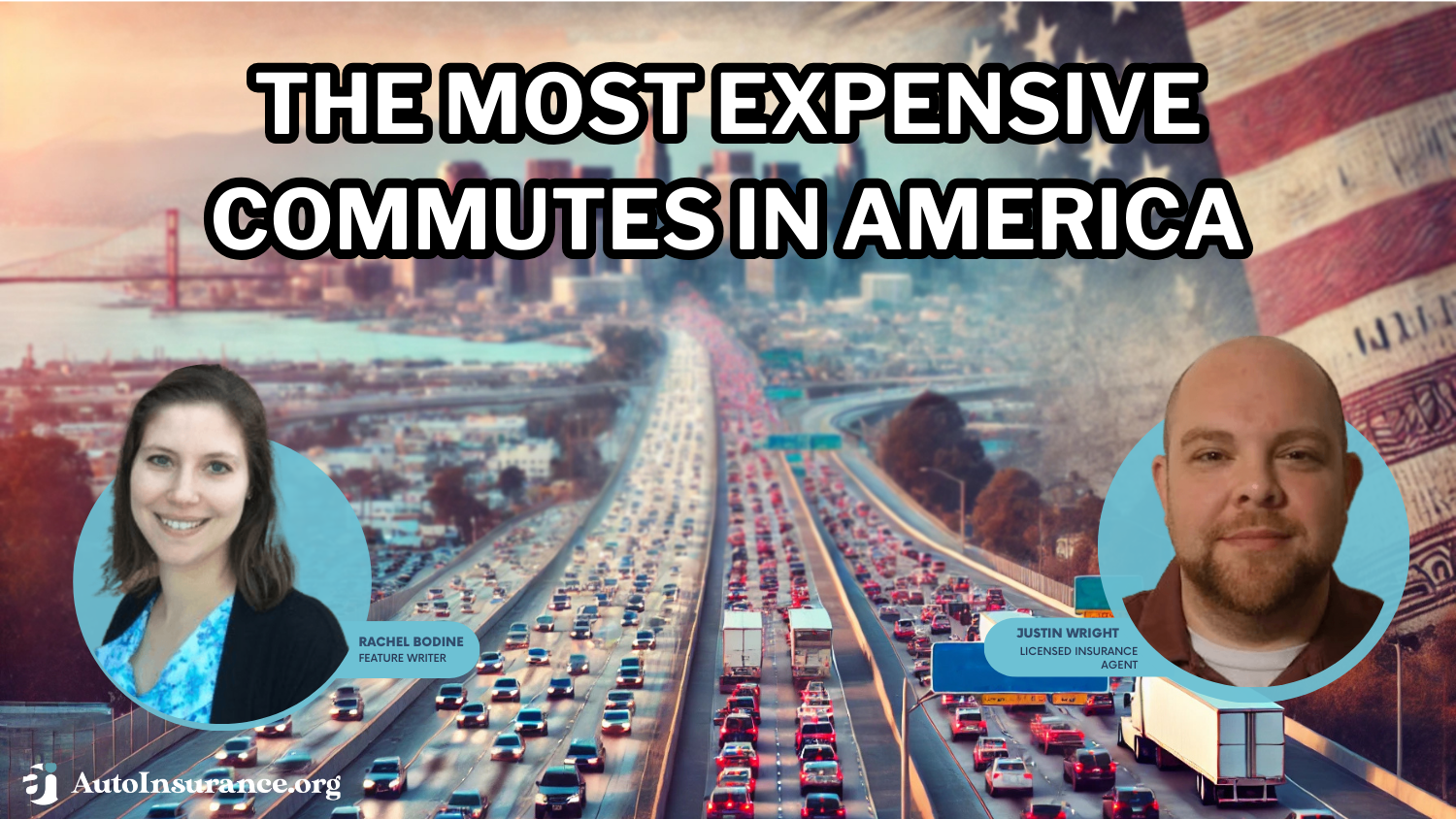
Frequently Asked Questions
Which city has the most expensive commute in the country?
Fremont, California, has the most expensive commute in the country.
What is the annual average commute cost in Arlington, Virginia?
The annual average commute cost in Arlington, Virginia, is $10,385.
Which state has the cheapest commute costs?
South Dakota has the cheapest commute costs among the states.
How did COVID-19 impact commuting?
COVID-19 led to a decrease in commuting as more people started working from home to curb the spread of the virus.
What is the term used to describe the mass resignation of workers during COVID-19?
The mass resignation of workers during COVID-19 is referred to as the Great Resignation.
Which city has the shortest average commute time among the top 10 most expensive cities?
Irvine, California, has the shortest average commute time among the top 10 most expensive cities.
What auto insurance discounts are available for people who work from home?
Some common auto insurance discounts for people who work from home include low mileage discounts and usage-based insurance programs.
How much money can you save with a low-mileage car insurance discount?
The amount of money you can save with a low-mileage car insurance discount varies depending on your insurance provider and your specific circumstances. However, it can typically range from 5% to 30% off your premium.
How much money can you save with usage-based auto insurance?
The amount of money you can save with usage-based auto insurance depends on your driving habits and the specific program offered by your insurance provider. On average, drivers can save up to 30% or more by participating in a usage-based insurance program.
Free Auto Insurance Comparison
Enter your ZIP code below to view companies that have cheap auto insurance rates.
Secured with SHA-256 Encryption
Justin Wright
Licensed Insurance Agent
Justin Wright has been a licensed insurance broker for over 9 years. After graduating from Southeastern Seminary with a Masters in Philosophy, Justin started his career as a professor, teaching Philosophy and Ethics. Later, Justin obtained both his Property & Casualty license and his Life and Health license and began working for State Farm and Allstate. In 2020, Justin began working as an i...
Editorial Guidelines: We are a free online resource for anyone interested in learning more about auto insurance. Our goal is to be an objective, third-party resource for everything auto insurance related. We update our site regularly, and all content is reviewed by auto insurance experts.













